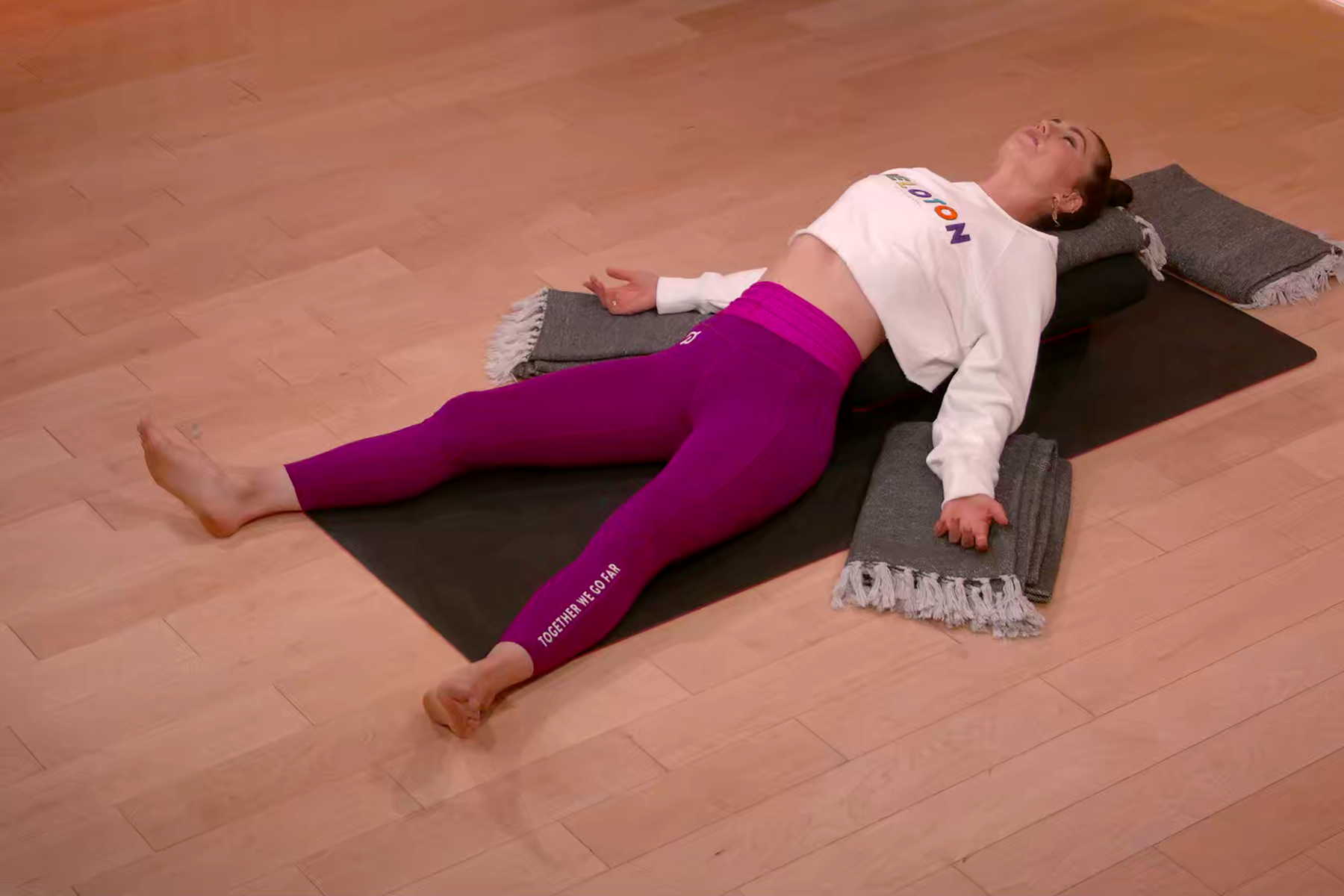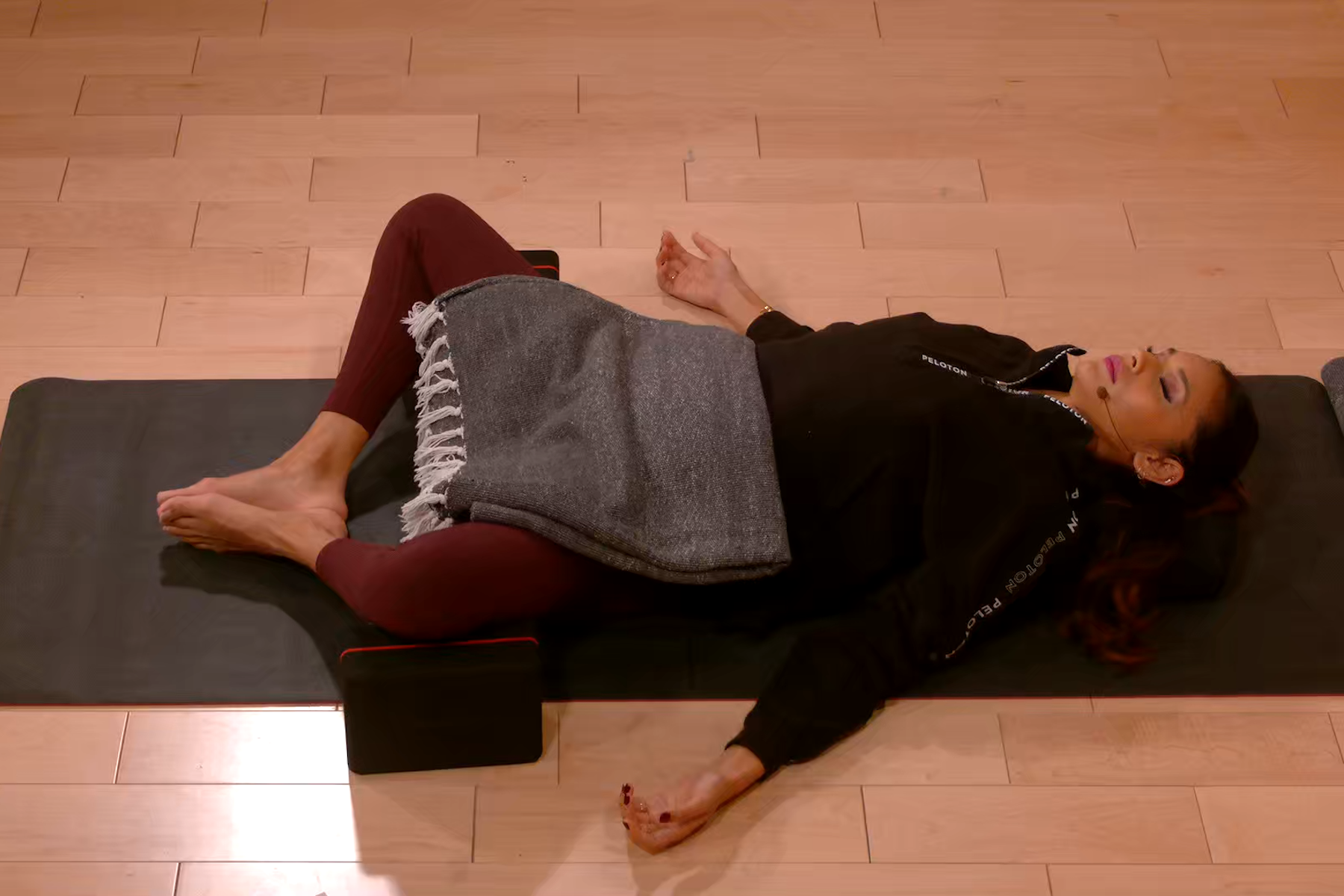
Calm Your Body and Mind with Restorative Yoga
Get the scoop on how good this type of yoga practice can feel.
By Peloton•
What Is Restorative Yoga?
Benefits of Restorative Yoga
Using Props in Restorative Yoga
Restorative Yoga Poses from Aditi Shah
Preparing for Class
With a jam-packed agenda during the week and a workout routine that rivals it, you may need to carve out some time to slow things down just a bit. Restorative yoga to the rescue!
Peloton instructor Aditi Shah’s Flow & Let Go series mixes active and restorative yoga postures to balance the flow of active and restorative energy in your body and calm your nervous system.
So, what is restorative yoga? It’s your opportunity to rest, reset, and reap the benefits of powering down. To learn more about restorative yoga in general, we talked with Aditi herself to understand more about how we can benefit from this specific practice.
What Is Restorative Yoga?
As the name suggests, this type of yoga is your time to restore and recover, both physically and mentally.
“Restorative yoga really aims to create the conditions for you to be able to truly rest,” says Aditi. “The goal is to tap into your parasympathetic nervous system—what is usually referred to as your ‘rest and digest’ state—where your body starts to conserve energy and slow your heart rate as opposed to when you are more active or, many times, even in a fight or flight mode.”
During restorative yoga, you’ll be able to achieve a more restful state using certain postures and props to get you there. It’s the opposite of active and more athletic styles of yoga, such as Vinyasa, Ashtanga, or power yoga.
“The poses you’ll be in are not like those in active styles of yoga (such as Warrior 2),” says Aditi. “The restorative yoga poses are closer to corpse pose (Savasana).”
Speaking of slowing down, there’s really no limit to how long you can stay in these poses as long as you’re comfortable.
“You can hold these postures anywhere from three to 15 minutes, depending on how much time you have,” says Aditi. “And I wouldn't think it was crazy if someone fell asleep since that’s how relaxing this should feel!”
Benefits of Restorative Yoga
Restorative yoga is a gentle, relaxing form of yoga. It can help you unwind, reduce stress, and improve your quality of life. Whether you're new to yoga or a seasoned practitioner, restorative yoga is a wonderful way to promote overall physical and mental wellness.
Here are a few of the many benefits of restorative yoga:
Unwinds Tension and Calms Your Nervous System
One of the key benefits of restorative yoga is its ability to help you release tension and stress, which can be particularly helpful for those who struggle with anxiety, insomnia, or chronic pain. By holding supported poses for several minutes, you give your muscles and connective tissue time to fully and completely relax, which can help promote good quality, restful sleep. Restorative yoga also focuses on deep breathing, which trigger the “rest and digest” function of your parasympathetic nervous system and help you wind down before bedtime.
Increases Flexibility and Strength
While restorative yoga may not be as physically demanding as other forms of yoga, it can still improve your flexibility, range of motion, and overall strength. By holding gentle stretches for longer periods of time, you allow your muscles and joints to gradually release tension and become more supple. This also translates into benefits like improving your posture, preventing injuries, and enhancing your physical performance in many realms.
Great for Any Fitness Level
The beauty of restorative yoga is that it can be easily modified to suit your unique needs and current fitness level. Whether you're rediscovering exercise after an absence, recovering from an injury, or just looking to relax and unwind, restorative yoga is a gentle and effective way to improve your health and well-being. (We also love it for a bedtime yoga sesh.)
Using Props in Restorative Yoga
Everyone could use an assist—and that’s where yoga class props come in. Yes, there are props, even for restorative yoga. No matter which prop you use, their goal is to make yoga class more comfortable, enjoyable and effective.
The following are perhaps the most common props used in this practice. With these and your yoga mat, you’ll be well on your way to a more relaxed, rejuvenated you.
Meditation Pillow
A meditation pillow, also known as a zafu cushion, is a firm cushion designed to provide support and comfort for seated postures. In restorative yoga, you can use this pillow to elevate your hips, support your spine, and just generally make it easier to sit comfortably on the floor. This is especially helpful for anyone with tight hips or lower back pain.
Yoga Block
A yoga block is a small, rectangular foam or cork block used to support your body in various poses—such as to support your spine, open the chest, and provide additional support for your arms or legs. When placed under your low back during a supported bridge pose, for example, the blocks can help release tension in the area so you can get a really good stretch.
Folded Blanket or Towel
A folded blanket or towel is another common prop used in restorative yoga. It can be used to provide support and comfort as you hold various poses. For example, placing a folded blanket or thick towel under the knees when in corpse pose (savasana) can provide much-needed support to the lower back, allowing you to sink deeper into the pose and be more relaxed than ever. These props can also be used to cushion the knees or hips in seated postures.
Restorative Yoga Poses from Aditi Shah
While there are several different yoga poses you can explore within restorative yoga, a few of Aditi’s favorites include supported fish pose, reclining bound angle (Supta Baddha Konasana) and simply propping your calves onto a chair—a variation of what we sometimes call “Stonehenge” in restorative yoga. Below, Aditi walks us through each of these postures so you can start benefiting from them today.
Supported Fish Pose

Sitting at a desk, using our phones or even working out encourages us to round our shoulders forward a lot throughout our day. The supported fish pose can correct this by subverting our natural posture and gently opening the chest and shoulders. It is often felt as relief in the muscles of the back.
Lie on your back, using yoga blocks under your spine.
One block should be beneath the shoulder blades (from bottom of shoulder blade up) and the other block should be under your head, or wherever is comfortable.
Let your chest fall open over the blocks.
Let your arms lay by your side.
Relax and hold this pose for however long feels comfortable for you.
Calves on a Chair
This pose is beneficial for releasing tension from your lower back, resting your legs and aiding digestion. It is a less intense option than putting your legs up a wall.
Lie on your back facing a chair or other supportive structure.
Prop your calves onto the seat of the chair or the top of the structure.
Move closer to it so each calf is entirely on top of it.
Relax and hold this pose for however long feels comfortable for you.
Reclining Bound Angle Pose (Supta Baddha Konasana)

Running and cycling can leave our hips tight. This posture is a gentle hip opener and adductor stretch.
Lie on your back.
Let your knees fall open to each side creating a butterfly shape.
Place blocks underneath the outside part of each knee at a height that feels comfortable for you.
Relax and hold this pose for however long feels comfortable.
Preparing for Class
If this is your first time doing any type of yoga, there are some things you should know before taking your first restorative yoga class.
Restorative yoga is a gentle, slow-paced practice that focuses on deep relaxation, stress reduction, and rejuvenation. In a restorative yoga class, you can expect to spend most of your time in comfortable, supported poses, using props such as blankets, blocks, and blankets to help you release tension and let go of stress.
Second, as a newbie, you’ve found yourself in the right place. Restorative yoga is a great choice for yoga beginners. You can move through the poses at your own pace and make modifications as needed. Your yoga teacher will offer possible adjustments, based on your current flexibility and fitness level. No matter what, remember to listen to your body. Only do what feels comfortable for you. With restorative yoga, there is no need to push your body—and you certainly don’t need to do everything the first time out.
Lastly, you should be prepared to let go of your worries and sink into a deep state of relaxation during yoga class. Restorative yoga is all about slowing down, quieting your mind, and getting in tune with your body and breathing. So, come with an open mind, a willingness to relax, and let your worries melt away during your restorative yoga class.
Ready to tap into some mind- and body-altering restorative yoga?
Peloton offers several yoga collections, each offering a variety of benefits, movements, and instructors. You can start by choosing the collection closest to your yoga goals, such as Foundation, Power, Focus, Recovery and Unity.
Of course, Peloton instructor Aditi Shah’s signature series, Flow & Let Go, is a great place to start. Or try all the Peloton classes; subscribe to the Peloton App today and get the first 30 days free.
Level up your inbox.
Subscribe for a weekly dose of fitness, plus the latest promos, launches, and events.